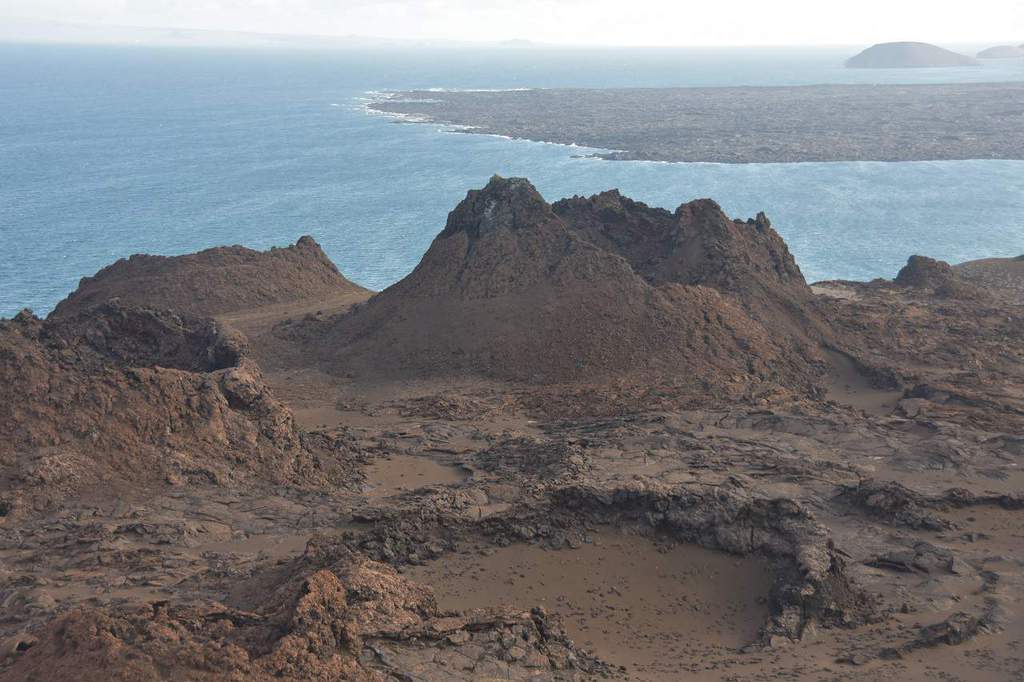A Deep Dive: Galapagos Islands Travel Guide
The Galapagos Islands are an enchanting isolated group of volcanic islands situated in the Pacific Ocean along the equator that inspired Charles Darwin’s theory of evolution by natural selection. There’s no other place like it in the world. This archipelago of at least 19 islands and many islets is a paradise for wildlife, nature, and adventure lovers.
Each island, while completely unique from the last, is equally alluring. Beaches of white, gold, red, or olive-green sand, black lava rocks, harsh desert-like terrain appearing extraterrestrial in parts and green tropical life in others, all add to the majesty and mysteries of these islands. These remote islands, classified as a UNESCO World Heritage Site, are located about 600 miles west from mainland Ecuador where three major ocean currents meet creating an underwater world rich in nutrients and abundant aquatic life.
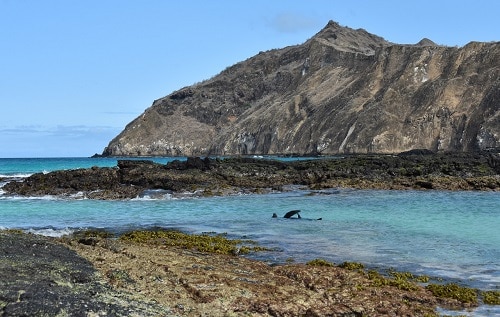
Wildlife reigns supreme on this protected nature reserve. Only five of the islands are inhabited by humans (Santa Cruz, San Cristobal, Isabela, Floreana, and Baltra). Most of the wildlife and many of the plant species are endemic to the islands. It’s the land of giant land tortoises, marine and land iguanas, Galapagos penguins, blue-footed Boobies, Galapagos sea lions, crabs, lava lizards, frigates, finches, waved albatrosses, many other bird species, sea turtles, sharks, and schools of colorful tropical fish.
Immerse yourself in the pristine mostly untouched Galapagos Islands by living aboard a boat, cruising from island-to-island, and discovering the wonders and wildlife of this exotic land by hiking and snorkeling all day.
When and Where to Go
The Galapagos Islands are a year-round paradise destination. Its location right along the equator keeps the temperatures fairly constant throughout the year. Air temperatures range from ~69-84°F and surface water temperatures generally average in the low-to-mid 70s°F. The water temperature is cooler than many may expect due to the powerful and cold Humboldt Current coming up from Antarctica.
The sea and land temperatures tend to be the warmest from January through March. August through November tend to be the coldest months. The seas are calmest from December through May. Overcrowding of tourists shouldn’t be a problem since the number of visitors are strictly regulated.
If you’re like me and your heart is set on seeing particular species, when choosing your itinerary, check whether the species is seasonal, animal behaviors, and which islands to visit, as many species only live on select islands. Whichever islands you choose, you are sure to have an unforgettable trip.
Things You Must Do / See on the Galapagos Islands
My “must-see” was the Galapagos Penguins. The Galapagos Penguins are the only penguins in the world living in the wild north of and along the equator. Most live on Isabela and Fernandina Islands where they normally breed. They are also often seen on Santiago, Bartolome, and sometimes Floreana. We swam with penguins off the shores of Bartolome Island, and then again at the Sombrero Chino/Chinese Hat Islet near Santiago Island. They are small, fast, dive down like rockets, and are simply extraordinary creatures.
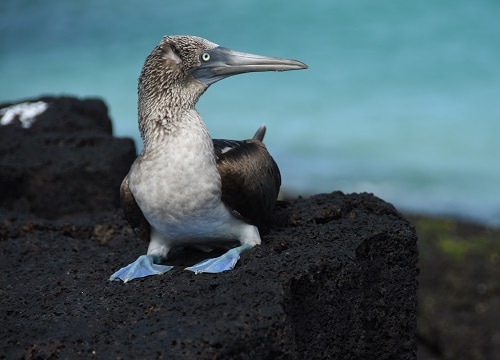
Many of the islands are home to Blue-footed Boobies, finches, mockingbirds, Galapagos marine iguanas, lava lizards, and sea turtles. The largest colonies of marine iguanas are found on Fernandina and Isabela Islands. Marine iguanas are unique because they forage under the sea, feeding mainly on seaweed and algae.
It seemed the Galapagos sea lions and fur sea lions were everywhere. They waddle awkwardly on land and barked at us if they thought we got too close. In the water, they swam gracefully around us, and a couple times, playful sea lions brushed against us. There were dozens of sea lions at the dock at Puerto Baquerizo Moreno after we first landed in San Cristobal wandering around and spread out on wooden benches. Sea lion babies may be seen between June and November. In late November, we saw more baby sea lion pups than I could count on Mosquera Islet, and then again on the Sombrero Chino (an islet named after its sloping rocky shape resembling that of a traditional Chinaman’s hat).
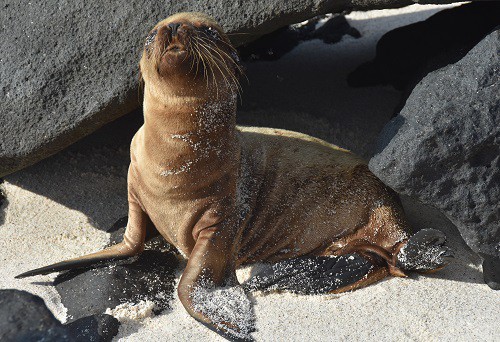
Galapagos Tortoises inhabit San Cruz, San Cristobal, Isabela, Santiago, Española, Pinta, and Pinzon. Galapagos Tortoises weigh between 330-550 pounds and have a lifespan averaging over 100 years. We observed the interactions of large tortoises huddled together and eating greenery at Santa Cruz’s natural tortoise reserve in the Highlands, and at the Cerro Colorado Tortoise Reserve on San Cristobal. We learned about their life cycle, history, the differences between tortoises and sea turtles, and saw itty bitty baby tortoises no larger than my palm. There’s also a Tortoise Breeding Center on Isabela Island.
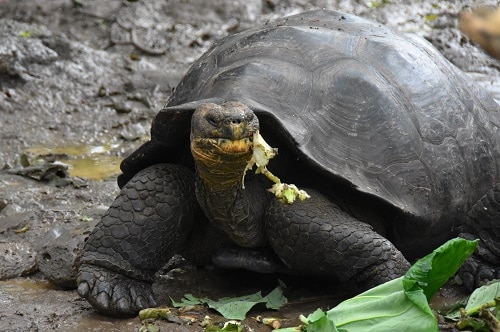
Galapagos Land Iguanas mostly live on South Plaza, Santa Cruz, North Seymour, Baltra. Isabela, and Fernandina.
Red-footed Boobies live on Pitt Point on San Cristobal, Genovesa, Darwin, and Wolf. Nazca Boobies are found on Pitt Point, Genovesa, Española, and Floreana. Pitt Point may be the only known place in the world where the three booby species (blue-footed, red-footed, and Nazca) can be seen together.
Flightless Cormorant live on parts of Isabela and Fernandina Islands. Friagatebirds are often seen on San Cristobal, North Seymour, Genovesa, Isabela, and Floreana. Flamingos may be seen on Isabela, Santiago, Rabida, Santa Cruz, and Floreana. The Waved Albatross nests on Española from April to December.
Volcanic Exploration
Aside from the incredible and abundant wildlife, the diversity of the islands with varied landscapes is remarkable. There are 13 active volcanoes, 5 of which are on sea-horse shaped Isabela Island, beaches, lava tunnels, lava fields, desert-like landscapes, lagoons, swamps, mangroves, harsh barren land, forests of cacti, and prickly pear cactus trees. Many islands have beaches covered in soft pristine white powdery sand splattered with barren black lava rock. Rabida Island has a dark red sanded beach. Cormorant Point on Floreana Island has an olive-green sanded beach.
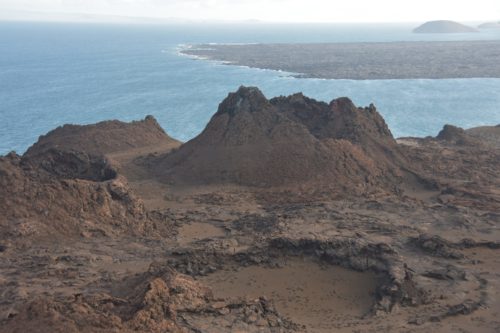
The majestic moonscape terrain of the volcanic Bartolomé Island resembles another planet. In the midst of the extreme and imposing landscape and protruding rock structures is a soft gold sanded beach. A 1.5 hour trail along volcanic ash and a wooden boardwalk guides you up 372 steps to the summit of Bartolome to marvel at and capture perhaps the most photographed site of the islands, Pinnacle Rock.
The stunning shoreline of Cerro Brujo on San Cristobal Island with white sand as soft as flour, the aqua-teal sea, the greenish colored algae wrapped around the black lava rocks, the plentiful and playful wildlife, and the rock structures protruding out of the water make this the most beautiful and memorable beach I have ever visited. Sprinkled among dozens of sea lions congregating on the beach and gracefully swimming right off the shore were iguanas and bright red crabs while frigates and blue-footed boobies flew overhead.
Things to Know Before you Go
The currency is the US dollar, Spanish is the official language, don’t consume the tap water (not even for brushing your teeth), and while the Galapagos Islands are 1 hour behind mainland Ecuador, your boat may stay on mainland Ecuador’s time (ours did).
Many rules and regulations are in place to sustain this wildlife paradise. Tourists to protected areas must be accompanied by a certified naturalist guide. Stay with your guide and follow the trail at all times. Be mindful of where you step as to avoid stepping on a nest or other wildlife. Don’t feed any animals and keep a distance of at least 2 meters from all wildlife, but they may, and often do, come closer to you. Do not remove anything and do not leave anything behind. Flash photography of wildlife is prohibited (absent special authorization).
Traveling to the Galapagos Islands
Traveling to the Galapagos Islands first requires a flight to either Quito (UIO) or Guayaquil in mainland Ecuador and then transferring to the archipelago by flying into either Baltra or San Cristobal. Allow extra time at the airport to complete forms and expect to be thoroughly scanned on your way there that you’re not bringing prohibited items such as seeds, fresh fruits, vegetables, plants, or animals, and then again on your way back home that you’re not taking anything forbidden back with you. Check for updates on flight deals into Ecuador here.
You will need to obtain your Transit Control Card ($20) in the Quito or Guayaquil airport. The Galapagos National Park Tax ($100 for foreign tourists over 12 years old/$50 for foreign tourists under 12) is an entrance fee paid at the Baltra or San Cristobal airport, which helps fund the continued conservation of the islands.
Baltra is separated by Santa Cruz by a channel and is visited by most tourists nearly exclusively for the purpose of arrival and/or departure from the archipelago via the airport and are then transferred to Santa Cruz by a bus-ferry-bus system.
From the San Cristobal airport, the drive to the dock where most cruises are anchored is less than a 5 minute drive. From the dock, we hopped onto a zodiac to be taken the short distance to our yacht.
Explore by Sea
The vessel options range from budget to luxurious of various sizes from about 8-20 passengers to not more than 100 (the maximum size permitted). A smaller vessel provides a more relaxed and intimate atmosphere with increased flexibility and all passengers go on excursions together. The larger the vessel, the better the stability and the on-board amenities tend to be, but you may have less time exploring the islands since passengers will need to take turns as we were informed the Galapagos National Park permits land tours to only ~20 persons per group. When comparing prices, ensure to review where the boat sails, the number of passengers, and all inclusions or additional fees.
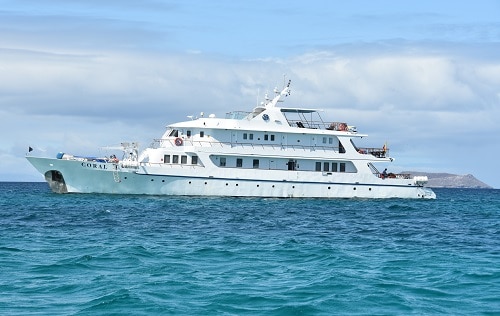
We had an unforgettable and adventure-packed time with Klein Tours aboard an elegant Coral yacht. The Coral I accommodates 36 passengers, and the Coral II accommodates only 20. The cruise itinerary options range from 3-4 nights with extensions up to 14 nights. The cost ranges from ~$1,800 for 4 days, ~$2,500 for 5 days, ~$3,900 for 8 days, and up to ~$7,200 for 15 days per person for a standard cabin.
Sample Full Day: Wake up every morning with the sun rising over the horizon revealing the shape of a new island to explore. You can expect to visit the islands twice each day and have excursions of hiking and/or snorkeling in the morning and then again after lunch. You travel to the shores of the island and to your snorkeling spots by zodiac and sometimes tour areas by zodiac.
Accommodations: All cabins are equipped with private bathrooms and showers. Separated twin beds, matrimonial beds, triple bed options, and connecting doors are available. Large windows (not portholes) make the junior cabin enviable to the standard cabins.
Common Areas: There are spacious outdoor observation decks along three levels. There’s a Jacuzzi, and the top deck is perfect for sunbathing while sailing to the next destination between excursions, admiring the dazzling stars of the unpolluted night sky, or being treated to a special BBQ dinner at sunset. The ceiling, walls, and bar of the main interior lounge area are lined with wood and has comfortable couches and coffee tables.
Meals: Our meals were served buffet style and typically consisted of some kind of meat (chicken or beef), a type of fish, a carbohydrate (either rice or pasta), vegetables, salad, bread, and cheese. There was almost always snacks and juice waiting for us whenever we returned back to the boat from an excursion.
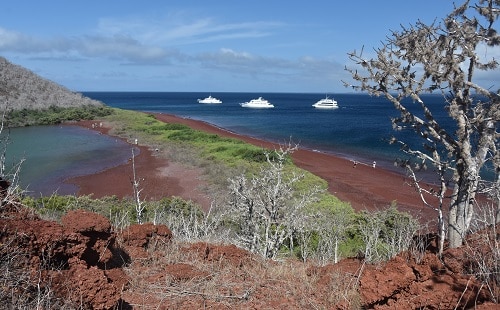
Scuba Diving the Galapagos
If you plan on diving, ensure you pick a tour operator authorized for this and inquire about the level of diving required as many dive sites are only for advanced divers. Cruise options with a primary focus on diving include the Galapagos Sky, Nortada, and the Humboldt Explorer. Darwin Island, the northernmost island, along with Wolf Island, are world famous for diving.
Land Based Travel is an Option
Land based travel is becoming a more popular option for more budget conscious travelers or those who prefer hotels over cruises. While it is generally less expensive than the cruises, there are luxury options, as well, but you will be restricted to visiting islands reachable by day trips as it is only possible to spend the night on a few of the islands, and a lot of your time may be spent traveling to and from your base island(s). Hotel options are available on Santa Cruz, San Cristobal, Isabela, and Floreana.
Passenger transport boats operate like a hub-and-spoke from Santa Cruz to either San Cristobal, Isabela, or Floreana, and then returning back to Santa Cruz. The total trip time generally takes between 2 to 3 hours one-way. The schedule is located on the Galapagos National Park website. You can also look into arranging daytrips to other islands. If you’re doing a land based tour, I’d recommend flying into Santa Cruz (via the Baltra airport) and then fly out of San Cristobal (or vice-versa) for the most efficient use of your time.
Packing List
Bathing Suit – at least 2 recommended
Sandals/Flip Flops
Hiking Shoes
Water Shoes
Tropical Clothes
Light Jacket/Sweater
Rain Jacket
Hats
Sunglasses
Camera and Accessories
Go Pro
Waterproof Bag for Electronics (particularly important while on the zodiacs)
Binoculars
Reef Safe Sunscreen – Purchasing sunscreen on the islands can be expensive if you forget.
Dramamine and Other Medications – I may have been the only passenger on our boat that wasn’t impacted by the motion during transit to other islands.
